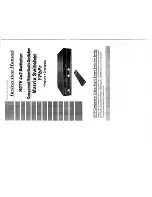
– 365 –
C
HAPTER
15
| Basic Administration Protocols
Link Layer Discovery Protocol
◆
System Capabilities Supported
– The capabilities that define the
primary function(s) of the system. (See
Table 18, "System
Capabilities," on page 362
.)
◆
System Capabilities Enabled
– The primary function(s) of the
system which are currently enabled. (See
Table 18, "System
Capabilities," on page 362
.)
◆
Management Address List
– The management addresses for this
device. Since there are typically a number of different addresses
associated with a Layer 3 device, an individual LLDP PDU may contain
more than one management address TLV.
Port Details – 802.1 Extension Information
◆
Remote Port VID
– The port’s default VLAN identifier (PVID) indicates
the VLAN with which untagged or priority-tagged frames are
associated.
◆
Remote VLAN Name List
– VLAN names associated with a port.
◆
Remote Protocol Identity List
– Information about particular
protocols that are accessible through a port. This object represents an
arbitrary local integer value used by this agent to identify a particular
protocol identity, and an octet string used to identify the protocols
associated with a port of the remote system.
Port Details – 802.3 Extension Port Information
◆
Remote Port Auto-Neg Supported
– Shows whether the given port
(associated with remote system) supports auto-negotiation.
◆
Remote Port Auto-Neg Adv-Capability
– The value (bitmap) of the
ifMauAutoNegCapAdvertisedBits object (defined in IETF RFC 3636)
which is associated with a port on the remote system.
Table 20: Remote Port Auto-Negotiation Advertised Capability
Bit
Capability
0
other or unknown
1
10BASE-T half duplex mode
2
10BASE-T full duplex mode
3
100BASE-T4
4
100BASE-TX half duplex mode
5
100BASE-TX full duplex mode
6
100BASE-T2 half duplex mode
7
100BASE-T2 full duplex mode
8
PAUSE for full-duplex links
9
Asymmetric PAUSE for full-duplex links
10
Symmetric PAUSE for full-duplex links
Summary of Contents for LGB6026A
Page 6: ...ABOUT THIS GUIDE 4...
Page 40: ...38 CONTENTS...
Page 60: ...58 SECTION I Getting Started...
Page 86: ...84 SECTION II Web Configuration Unicast Routing on page 517 Multicast Routing on page 575...
Page 162: ...160 CHAPTER 5 Interface Configuration VLAN Trunking...
Page 196: ...194 CHAPTER 6 VLAN Configuration Configuring MAC based VLANs...
Page 204: ...CHAPTER 7 Address Table Settings Clearing the Dynamic Address Table 202...
Page 238: ...CHAPTER 11 Class of Service Layer 2 Queue Settings 236...
Page 254: ...252 CHAPTER 12 Quality of Service Attaching a Policy Map to a Port...
Page 448: ...446 CHAPTER 16 Multicast Filtering Multicast VLAN Registration...
Page 470: ...468 CHAPTER 17 IP Configuration Setting the Switch s IP Address IP Version 6...
Page 576: ...574 CHAPTER 21 Unicast Routing Configuring the Open Shortest Path First Protocol Version 2...
Page 606: ...604 CHAPTER 22 Multicast Routing Configuring PIMv6 for IPv6...
Page 620: ...618 CHAPTER 23 Using the Command Line Interface CLI Command Groups...
Page 672: ...670 CHAPTER 25 System Management Commands Time Range...
Page 692: ...690 CHAPTER 26 SNMP Commands...
Page 700: ...698 CHAPTER 27 Remote Monitoring Commands...
Page 854: ...CHAPTER 34 Port Mirroring Commands Local Port Mirroring Commands 852...
Page 862: ...860 CHAPTER 36 Address Table Commands...
Page 958: ...956 CHAPTER 40 Quality of Service Commands...
Page 1034: ...1032 CHAPTER 42 LLDP Commands...
Page 1044: ...1042 CHAPTER 43 Domain Name Service Commands...
Page 1062: ...1060 CHAPTER 44 DHCP Commands DHCP Server...
Page 1206: ...CHAPTER 47 IP Routing Commands Open Shortest Path First OSPFv3 1204...
Page 1250: ...1248 SECTION IV Appendices...
Page 1256: ...1254 APPENDIX A Software Specifications Management Information Bases...
Page 1278: ...1276 COMMAND LIST...
















































